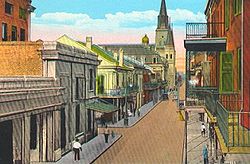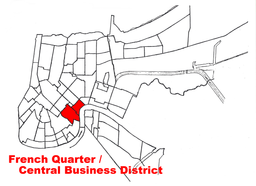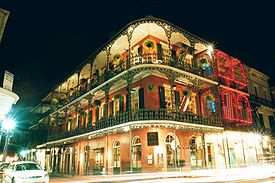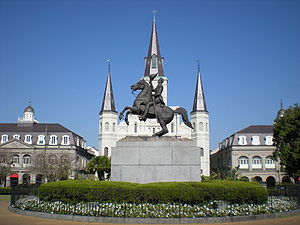- French Quarter
-
This article is about the French Quarter in New Orleans. For other cities with "French Quarter" areas, see French Quarter (disambiguation).
French Quarter Vieux Carré New Orleans Neighborhood The French QuarterCountry United States State Louisiana City New Orleans Planning District District 1, French Quarter/CBD Elevation 3 ft (0.9 m) Coordinates 29°57′31″N 90°03′54″W / 29.95861°N 90.065°W Area 0.66 sq mi (1.7 km2) - land 0.49 sq mi (1 km2) - water 0.17 sq mi (0 km2), 25.76% Population 3,888 (2010) Density 5,891 / sq mi (2,275 / km2) Mayor Mitch Landrieu Timezone CST (UTC-6) - summer (DST) CDT (UTC-5) ZIP Codes 70116 - 70130 Area code 504 Location of the French Quarter and Central Business District in New OrleansThe French Quarter, also known as Vieux Carré, is the oldest neighborhood in the city of New Orleans. When New Orleans (La Nouvelle-Orléans in French) was founded in 1718 by Jean-Baptiste Le Moyne de Bienville, the city was originally centered on the French Quarter, or the Vieux Carré ("Old Square" in French) as it was known then. While the area is still referred to as the Vieux Carré by some, it is more commonly known as the French Quarter today, or simply "The Quarter."[1] The district as a whole is a National Historic Landmark, and contains numerous individual historic buildings. It was affected relatively lightly by Hurricane Katrina in 2005, as compared to other areas of the city and the greater region.
Contents
Geography
The French Quarter is located at 29°57′31″N 90°03′54″W / 29.95861°N 90.065°W[2] and has an elevation of 3 feet (0.9 m).[3] According to the United States Census Bureau, the district has a total area of 0.66 square miles (1.7 km2). 0.49 square miles (1.3 km2) of which is land and 0.17 square miles (0.4 km2) (25.76%) of which is water.
Boundaries
The most common definition of the French Quarter includes all the land stretching along the Mississippi River from Canal Street to Esplanade Avenue (12 blocks) and inland to North Rampart Street (seven to nine blocks). It equals an area of 78 sq. blocks. Some definitions, such as city zoning laws, exclude the properties facing Canal Street, which had already been redeveloped by the time architectural preservation was considered, and the section between Decatur Street and the river, much of which had long served industrial and warehousing functions. Any alteration to structures in the remaining blocks is subject to review by the Vieux Carré Commission, which determines whether the proposal is appropriate for the historic character of the district. Its boundaries as defined by the City Planning Commission are: Esplanade Avenue to the north, the Mississippi River to the east, Canal Street, Decatur Street and Iberville Street to the south and the Basin Street, St. Louis Street and North Rampart Street to the west.[4]
The National Historic Landmark district is stated to be 85 square blocks.[5][6] The Quarter is subdistrict of the French Quarter/CBD Area.
Adjacent neighborhoods
Further information: New Orleans neighborhoods- Faubourg Marigny (east)
- Mississippi River (east)
- Central Business District (south)
- Iberville (west)
- Treme (west)
Demographics
As of the census[7] of 2000, there were 4,176 people, 2,908 households, and 509 families residing in the neighborhood. The population density was 8,523 /mi² (3,212 /km²).
History
Vieux Carre Historic District French Quarter: Upper Chartres street looking towards Jackson Square and the spires of St. Louis Cathedral.
French Quarter: Upper Chartres street looking towards Jackson Square and the spires of St. Louis Cathedral.Location: New Orleans, Louisiana Built: 1734 Architect: Multiple Architectural style: No Style Listed Governing body: Local NRHP Reference#: 66000377 Significant dates Added to NRHP: October 15, 1966[8] Designated NHLD: December 21, 1965[5] Many of the buildings date from before New Orleans became part of the United States, although there are some late 19th century and early 20th century buildings in the area as well. Since the 1920s the historic buildings have been protected by law and cannot be demolished, and any renovations or new construction in the neighborhood must be done according to regulations to match the period historic architectural style.
Most of the French Quarter's architecture was built during the time of Spanish rule over New Orleans and this is reflected in its architecture. The Great New Orleans Fire (1788) and another great fire in 1794 destroyed most of the Quarter's old French colonial architecture, leaving the colony's new Spanish overlords to rebuild it according to more modern tastes—and strict new fire codes, which mandated that all structures be physically adjacent and close to the curb to create a firewall. The old French peaked roofs were replaced with flat tiled ones, and now-banned wooden siding with fire-resistant stucco, painted in the pastel hues fashionable at the time. As a result, colorful walls and roofs and elaborately decorated ironwork balconies and galleries, from both the 18th century and the early 19th century, abound. (In southeast Louisiana, a distinction is made between "balconies", which are self supporting and attached to the side of the building, and "galleries" which are supported from the ground by poles or columns.)
When Anglophone Americans began to move in after the Louisiana Purchase, they mostly built just upriver, across modern day Canal Street, which became the meeting place of two cultures, one Francophone Creole and the other Anglophone American. (Local landowners had retained architect and surveyor Barthelemy Lafon to subdivide their property to create an American suburb). The median of the wide boulevard became a place where the two contentious cultures could meet and bilingually do business. As such, it became known as the "neutral ground", and this name persists in the New Orleans area for medians.
Even before the Civil War, French Creoles had become a minority in the French Quarter.[9] In the late 19th century the Quarter became a less fashionable part of town, and many immigrants from southern Italy and Ireland settled there. In 1905, the Italian consul estimated that one-third to one-half of the Quarter’s population were Italian-born or second generation Italian-Americans.[10]
In 1917, the closure of Storyville sent much of the vice formerly concentrated therein back into the French Quarter, which "for most of the remaining French Creole families . . was the last straw, and they began to move uptown."[11] This, combined with the loss of the French Opera House two years later, provided a bookend to the era of French Creole culture in the Quarter.[12]
In the early 20th century the Quarter's cheap rents and air of age and decay attracted a bohemian artistic community, a trend which became pronounced in the 1920s. Many of these new inhabitants were active in the first preservation efforts in the Quarter, which began around that time.[13] As a result the Vieux Carré Commission (VCC) was established in 1925. Although initially only an advisory body, a 1936 referendum to amend the Louisiana constitution afforded it a measure of regulatory power.[14]
On December 21, 1965, the "Vieux Carre Historic District" was designated a National Historic Landmark.[5][6] Preservation activities were led by Jacob Haight Morrison (1905–1974), a lawyer who headed the Vieux Carré Property Owners association. He was the half-brother of Mayor deLesseps Story Morrison (1912–1963)
In the 1980s many long-term residents were driven away by rising rents as property values rose dramatically with expectations of windfalls from the planned 1984 World's Fair nearby. More of the neighborhood became developed for the benefit of tourism. The French Quarter remains a combination of residential, hotels, guest houses, bars, and tourist-oriented commercial properties.
Impact of Hurricane Katrina
Main article: Effect of Hurricane Katrina on New OrleansAt the end of August 2005, the majority of New Orleans was flooded due to levee breaches after Hurricane Katrina. The French Quarter, like most parts of town developed before the late 19th century, was one of the areas to remain substantially dry, since it was built on dry land that predated New Orleans' levee systems and sits 5 feet (1.5 m) above sea level.[15] Some streets experienced minor flooding, and several buildings experienced significant wind damage. Most of the major landmarks suffered only minor damage.[16] The Quarter largely escaped the looting and violence after the storm; nearly all of the antique shops and art galleries in the French Quarter, for example, were untouched.[17]
Mayor Ray Nagin officially reopened the French Quarter on September 26, 2005 to business owners to inspect property and clean up. Within a month, a large selection of French Quarter businesses were back open. The Historic New Orleans Collection's Williams Research Center annex was the first new construction completed in the French Quarter after Hurricane Katrina.[18]
Landmarks and attractions
Jackson Square
Main article: Jackson Square, New Orleans, LouisianaJackson statue and Saint Louis Cathedral
Jackson Square (formerly Place d'Armes), originally designed by architect and landscaper Louis H. Pilié (although he is only given credit for the iron fence), is an open park the size of a city-block located at the center of the French Quarter ( GPS +29.95748 -090.06310 ). After the Battle of New Orleans it was named after victorious general Andrew Jackson; an equestrian statue of Jackson is in the center of the park.
The square originally overlooked the Mississippi River across Decatur Street, but the view was blocked in the 19th century by the building of larger levees. The riverfront was long given to shipping, but the administration of Mayor Moon Landrieu put in a scenic boardwalk along the river across from the Square; it is known as the "Moon Walk" in his honor. At the end of the 1980s additional old wharfs and warehouses were demolished to create Woldenberg Park, extending the riverfront promenade up to Canal Street.
On the opposite side of the square from the River are three 18th‑century historic buildings which were the city's heart in the colonial era. The center of the three is St. Louis Cathedral. The cathedral was designated a minor basilica by Pope Paul VI. To its left is The Cabildo, the old city hall, now a museum, where the finalization of the Louisiana Purchase was signed. To the Cathedral's right is The Presbytere, built to match the Cabildo. The Presbytère, originally intended to house the city's Roman Catholic priests and authorities, was turned into a courthouse at the start of the 19th century, and in the 20th century became a museum.
On the other two sides of the square are the Pontalba Buildings, matching red-brick block long 4‑story buildings built in the 1840s. The ground floors house shops and restaurants; the upper floors are apartments that are the oldest continuously rented such apartments in the United States.
Directly across from Jackson Square is the Jax Brewery building, the original home of a local beer. After the company ceased to operate independently, the building was converted into several businesses, including restaurants and specialty shops. In recent years, some retail space has been converted into riverfront condominiums. Behind the Jax Brewery lies the Toulouse Street Wharf, the regular port of the steamboat Natchez.
From the 1920s through the 1980s the square was known as a gathering place of painters, young art students and caricaturists.[citation needed] In the 1990s the artists were joined by tarot card readers, mimes, fortune tellers, and street performers.
Live music has been a regular feature of the entire quarter, including the Square for more than a century. Formal concerts do take place, albeit rarely, and musicians are known to play for tips.
Diagonally across the square from the Cabildo is Café du Monde, open 24 hours a day, well known for the café au lait, coffee spiced with chicory, and beignets, served there continuously since the 19th century. It is a custom to blow the powdered sugar onto anyone who is going there for the first time, while making a wish.
-
The Rue Bourbon, or Bourbon Street, is named after the former royal family of France
Bourbon Street
Main article: Bourbon StreetThe most well known of the French Quarter streets, Bourbon Street, or Rue Bourbon, is known for its drinking establishments. Most of the bars frequented by tourists are new but the Quarter also has a number of notable bars with interesting histories.
The Old Absinthe House on Bourbon Street has kept its name even though for almost a century absinthe was illegal in the United States.
Pat O'Brien's Bar is well-known for both inventing the red cocktail, Hurricane, as well as having the first Dueling Piano Bar. Pat O'Brien's is located at 718 St. Peter Street.[19]
Lafitte's Blacksmith Shop is a tavern located on the corner of Bourbon Street and St. Philip Street. The tavern's building, built sometime before 1772, is one of the older still standing structures in New Orleans (the Ursuline Convent, for example, is older) and has been called the oldest continually occupied bar in the United States. According to legend the structure was once owned by the pirate Jean Lafitte, though as with many things involving Lafitte, no documentation of this exists.
The Napoleon House bar and restaurant is in the former home of mayor Nicholas Girod; the name comes from an unrealized plot to rescue Napoleon I from his exile in St. Helena and bring him to New Orleans.
The original Johnny White's bar is a favorite of bikers. In 2005 an off-shoot called Johnny White's Hole in the Wall, along with Molly's at the Market, drew national media attention as the only businesses in the city to stay open throughout Hurricane Katrina and the tribulations of the weeks after the storm.
The Bourbon Pub and Oz, both located at the intersection of Bourbon and St. Ann, are the two largest gay clubs in New Orleans. Café Lafitte in Exile, located at the intersection of Bourbon and Dumaine is the oldest continuously running gay bar in the United States. These and other gay establishments sponsor the raucous Southern Decadence Festival during Labor Day weekend. This festival is often referred to as New Orleans' "Gay Mardi Gras". St. Ann Street is often called "the Lavender Line" in reference to it being on the edge of the French Quarter's predominately gay district. While there is a gay population throughout the French Quarter, the portion of the Quarter that is northeast of St. Ann Street is generally considered to be the Gay District.
New Orleans and its French Quarter are one of only a few places in the United States where possession and consumption of alcohol in open containers is allowed on the street.[20]
Restaurants
The neighborhood contains many restaurants, ranging from formal to casual, patronized by both visitors and locals. Some are well known landmarks, such as Antoine's and Tujague's, which have been in business since the 19th century; Arnaud's, Galatoire's, Broussard's, and Brennan's are only slightly less venerable. Less historic—but also well-known—French Quarter restaurants include those run by chefs Paul Prudhomme ("K-Paul's"), Emeril Lagasse ("NOLA"), and John Besh. Port of Call on Esplanade Avenue has also been in business for more than 30 years and is recognized for its popular Monsoon drinks.
Hotels
There are several types of accommodations in the French Quarter ranging from large international chains to bed and breakfasts to time share condominiums to small guest houses with only one or two rooms. Hotel Maison De Ville and the Audubon Cottages were built as a townhouses in 1800. The Audubon Cottages were home to Antoine Amedée Peychaud during its history. Tennessee Williams (with the French Quarter providing the setting for arguably his most famous play, A Streetcar Named Desire) was a frequent guest and the hotel works to maintain its historic ambiance.
Education
Residents are within the jurisdiction of the New Orleans Public Schools.
See also
References
- ^ New Orleans French Quarter History, Architecture and Pictures
- ^ "US Gazetteer files: 2010, 2000, and 1990". United States Census Bureau. 2011-02-12. http://www.census.gov/geo/www/gazetteer/gazette.html. Retrieved 2011-04-23.
- ^ "US Board on Geographic Names". United States Geological Survey. 2007-10-25. http://geonames.usgs.gov. Retrieved 2008-01-31.
- ^ Greater New Orleans Community Data Center. "French Quarter Neighborhood". http://gnocdc.org/orleans/1/48/index.html. Retrieved 2008-06-21.
- ^ a b c "Vieux Carre Historic District". National Historic Landmark summary listing. National Park Service. http://tps.cr.nps.gov/nhl/detail.cfm?ResourceId=258&ResourceType=District. Retrieved 2008-01-31.
- ^ a b Patricia Heintzelman (February, 1975). National Register of Historic Places Inventory-Nomination: Vieux Carre Historic District. National Park Service. http://pdfhost.focus.nps.gov/docs/NHLS/Text/66000377.pdf
- ^ "American FactFinder". United States Census Bureau. http://factfinder.census.gov. Retrieved 2008-01-31.
- ^ "National Register Information System". National Register of Historic Places. National Park Service. 2007-01-23. http://nrhp.focus.nps.gov/natreg/docs/All_Data.html.
- ^ Ellis, Scott S. (2010). Madame Vieux Carré: the French Quarter in the Twentieth Century. University of Mississippi. p. 7. ISBN 978-1-60473-358-7.
- ^ Madame Vieux Carré, p. 11
- ^ Madame Vieux Carré, p. 20-21
- ^ Madame Vieux Carré, p. 21
- ^ Madame Vieux Carré, p. 24
- ^ Madame Vieux Carré, p. 43
- ^ Officials rescue Katrina's survivors amid 'chaos' By Rick Wilking, Wed Aug 31, 2005, retrieved on 2009-11-27.
- ^ FrenchQuarter.com: The Essential Guide to New Orleans' Oldest Neighborhood
- ^ Rosenblatt, Susannah; Rainey, James (September 27, 2005). "Katrina Takes a Toll on Truth, News Accuracy - Los Angeles Times". Los Angeles Times. http://www.latimes.com/news/nationworld/nation/la-na-rumors27sep27,0,5492806,full.story?coll=la-home-headlines.
- ^ THNOC - WRC Addition
- ^ Lind, Angus. "Home of the 'Hurricane' Pat O'Brien's turns 75 this week". nola.com. http://blog.nola.com/anguslind/2008/11/pat_os_turns_75_this_week.html. Retrieved 2009-06-19.
- ^ City of New Orleans memo
External links
- Harriet Joor: The City of Iron Lace
- National Historic Landmarks Program: Vieux Carré Historic District
- QuarterCrawl.com: An up-to-date list of what's open in the French Quarter
- Vieux Carré:A Creole Neighborhood in New Orleans, a National Park Service Teaching with Historic Places (TwHP) lesson plan
- WikiTravel:New Orleans/French Quarter
Neighborhoods of the French Quarter/Central Business District of New Orleans, Louisiana Central Business District | French Quarter
Planning Districts: French Quarter/CBD · Central City/Garden District · Uptown/Carrollton · Mid-City · Lakeview · Gentilly · Bywater · Lower Ninth Ward · New Orleans East · Village de L'Est · Venetian Isles/Lake Catherine · Algiers · English TurnU.S. National Register of Historic Places Topics Lists by states Alabama • Alaska • Arizona • Arkansas • California • Colorado • Connecticut • Delaware • Florida • Georgia • Hawaii • Idaho • Illinois • Indiana • Iowa • Kansas • Kentucky • Louisiana • Maine • Maryland • Massachusetts • Michigan • Minnesota • Mississippi • Missouri • Montana • Nebraska • Nevada • New Hampshire • New Jersey • New Mexico • New York • North Carolina • North Dakota • Ohio • Oklahoma • Oregon • Pennsylvania • Rhode Island • South Carolina • South Dakota • Tennessee • Texas • Utah • Vermont • Virginia • Washington • West Virginia • Wisconsin • WyomingLists by territories Lists by associated states Other City of New Orleans Topics History · Geography · Demographics · Economy · Culture · Healthcare · Media · Music · Sports · Architecture · Tourism · Education · Notable people · Skyscrapers · Streetcars · Flag · Lists

Government Neighborhoods French Quarter · Central Business District · Garden District · New Orleans East · Audubon · Uptown · Mid-City · Lakeview · Bywater · Lower Ninth Ward · Algiers · Gentilly · Metro area
Categories:- Historic districts in Louisiana
- Neighborhoods in New Orleans, Louisiana
- National Historic Landmarks in Louisiana
- Busking venues
- French Quarter
- Visitor attractions in New Orleans, Louisiana
Wikimedia Foundation. 2010.









